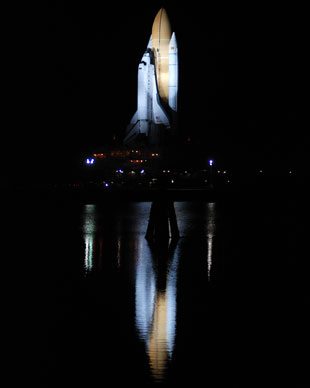April 22, 2010 — Space shuttle Atlantis held the spotlight late on Wednesday night into early Thursday morning as it rolled out of Kennedy Space Center's Vehicle Assembly Building (VAB) in Florida, on its way to the launch pad for what is planned as its last flight.
The black-and-white winged-orbiter, mounted to an orange external fuel tank and twin white solid rocket boosters, left the voluminous building -- the largest one-story building in the world -- just before midnight EDT Wednesday atop a mobile launcher platform and crawler transporter tracked vehicle. Bathed by brilliant white lights, Atlantis appeared to glow against the night sky, making for quite a sight.

Photo Gallery: Atlantis has left the building...
"One of my favorite shots, almost as fantastic as launch, is coming out here in the middle of the night, watching it clear the VAB doors. When it moves out into the Xenon lights and they're shining on it, there's just something very special about that," former astronaut and Kennedy Space Center director Bob Cabana told collectSPACE.com. "The beginning of this journey into space, it all starts when the whole stack rolls out."
Atlantis' beginning moves at 11:31 p.m. EDT Wednesday were also slated to be among its last.
Scheduled to lift off in mid-May to the International Space Station (ISS) to deliver a new Russian-built mini-research module, Atlantis' STS-132 mission will mark its 32nd, and as planned, last spaceflight.
"STS-132 is the last flight of Atlantis," confirmed NASA's space shuttle launch integration manager Mike Moses on Tuesday, addressing the speculation that another mission might be added based on the plan to have Atlantis readied to rescue the crew of the
final scheduled shuttle mission if an emergency arose. Only two flights are currently slated to fly after STS-132; STS-134 by shuttle Endeavour and STS-133 by Discovery.
"There has been a lot of talk from the administration about whether you go ahead and fly that rescue vehicle since you have the hardware... but there has been no decision made there and from a planning purpose standpoint we're still planning on STS-132 being the last flight of Atlantis," Moses explained.
"We've come up with a tagline," said STS-132 commander Ken Ham after Atlantis had arrived at the pad on Thursday at 6:03 a.m. EDT, 6 hours and 32 minutes after its rollout began. "This is the first last flight of Atlantis."
Thirty-nine rolls... and a half
Though STS-132 is Atlantis' 32nd launch, it has made the journey to the launch pad seven -- and a half -- additional times.
The fourth orbiter to join NASA's fleet, Atlantis completed its first rollout to the pad on August 30, 1985, five weeks before lifting off on its maiden flight, STS-51J, a classified mission for the Department of the Defense.

| Space shuttle Atlantis glows in the night and in its reflection as it moves to the launch pad for STS-132. (collectSPACE) |
Since then, over the past 25 years Atlantis has traversed the 3.5 to 4.2 miles (5.6 to 6.8 km) between the Vehicle Assembly Building and either pads 39A or 39B to deploy two planetary probes -- Galileo to Jupiter and Magellan to Venus; deploy the Compton Gamma Ray Observatory and service the Hubble Space Telescope; and visit both the Mir and International space stations.
Sometimes though, those missions required more than one visit to the pad.
Twice Atlantis needed to be rolled back to the VAB due to technical issues discovered while it was being readied for launch. Once the problems -- a hydrogen fuel leak in 1990 and a solid rocket booster cabling concern in 2001 -- were resolved, Atlantis was rolled out again to fly the STS-38 and STS-98 missions successfully.
In fact, Atlantis had already gone through a partial rollout for STS-98 even before the cabling issue was identified. A failed computer on the crawler moving the shuttle to the pad resulted in Atlantis retreating again into the VAB.
More recently, Atlantis was rolled to the pad and ready to launch when its mission's target, the Hubble telescope, suffered its own hardware failure. Atlantis was rolled back and didn't begin the
STS-125 mission until seven months later in May 2009.
Storms accounted for Atlantis' four and a half other round trips to the pad.
A hail storm in March 2007 resulted in damage to Atlantis' external tank for
STS-117. Repairs were made inside the assembly building and the shuttle was returned to the pad to fly.
The threat from approaching hurricanes caused Atlantis to take shelter in the VAB three times, and almost a fourth.
The half-rollout statistic, which is unique to Atlantis, came in August 2006 after what was forecasted to be a growing storm, Tropical Storm Ernesto, weakened. Already on its way back to the VAB, Atlantis' move was reversed and it returned to the pad to begin the
STS-115 mission 11 days later.
A very emotional moment
Atlantis' crew for the STS-132 mission was able to watch their ride to orbit leave for the launch pad, having arrived in Florida on Tuesday to take part in a dress rehearsal for their May 14th scheduled liftoff.

Photo Gallery: Atlantis and astronauts at the pad
Originally the astronauts were slated to come to Kennedy Space Center after Atlantis had reached the pad but rain storms delayed the shuttle's departure by several days.
The late rollout meant that the six crew members could also catch a ride with Atlantis.
"Riding the crawler... was absolutely fantastic," said Ham. "It was one of those moments that we shared with each other to remind us of the reality of what we're going to do,"
For Cabana, the rollout was similarly moving.
"To me, [it's] a very emotional moment," he said. "It's like it is pulling out of port, it's on its way. It is a three mile trip out to the pad and it's starting its journey to space. It is just phenomenal."
